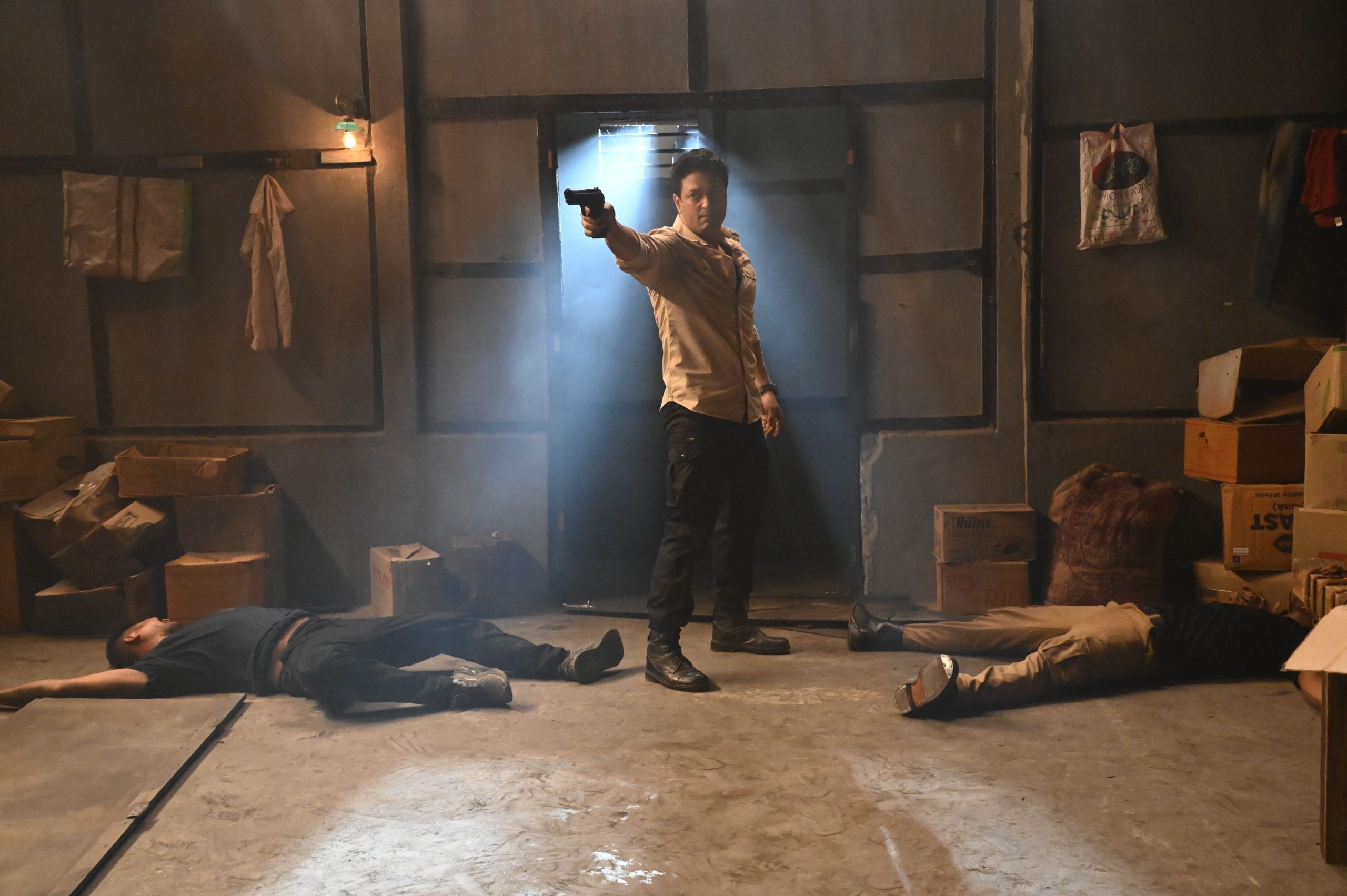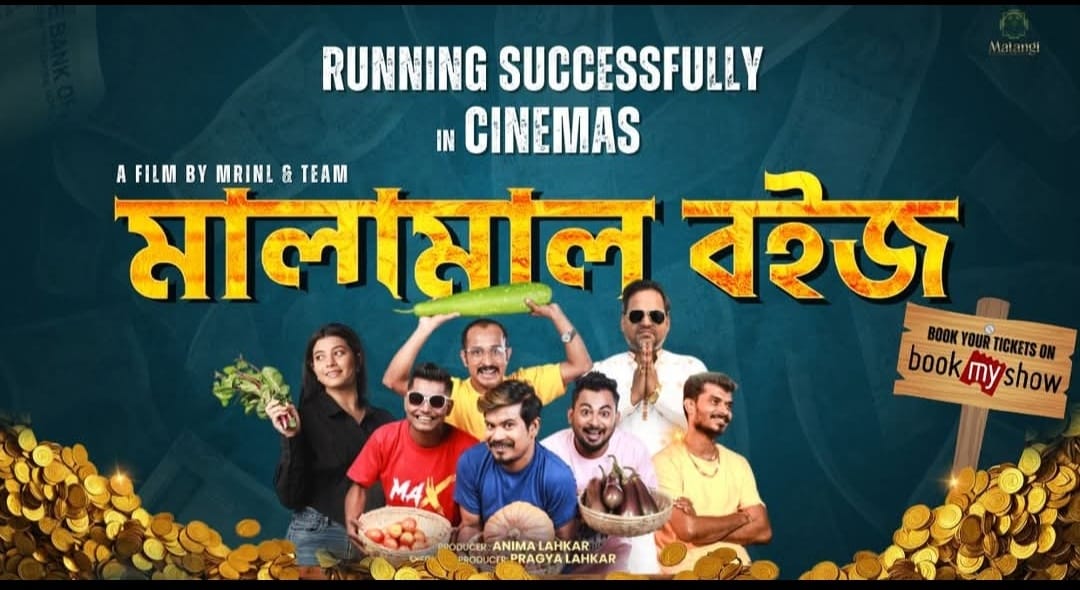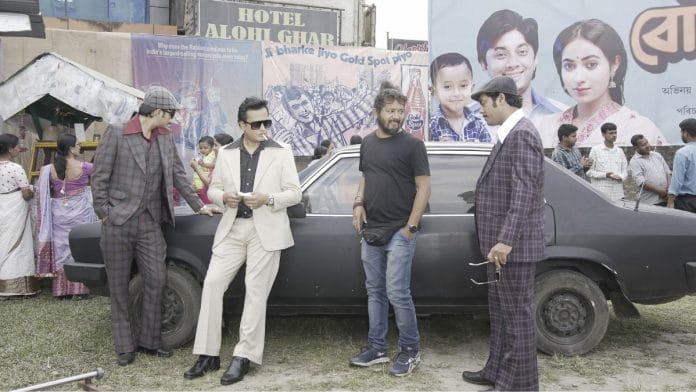New Delhi: Assamese director Sasanka Samir managed to do the unimaginable. He made a commercially successful biopic on filmmaker Munin Barua, the king of Assam’s commercial cinema. Samir’s Bhaimon Da — as Barua was affectionately called — has even had successful runs from Bengaluru to Sydney. Its songs and scenes are now ruling social media.
Bhaimon Da, released on 23 May, isn’t the only Assamese movie to have a successful box office run this year. In the four weeks following its release in June, Roopak Gogoi’s action thriller Rudra played to packed theatres — even as far south as Hyderabad and Chennai. And Mrinal Deka’s Malamal Boyyyz, released on 18 July, turned out to be a hit, becoming the third film of this trio with successful box office runs.
Within three months, these films have collectively earned Rs 20 crore at the box office. It’s a modest figure when compared to Bollywood and film industries in the South, but for the little-known Assamese film industry, it’s a giant step toward mainstream recognition.
“It is the rarest of the rare occurrence in the history of the Assamese film industry. Usually one movie works, and the rest don’t. But this time, we have three back-to-back successes, each in a different genre,” said film historian Parthajit Baruah.
With this hat-trick, the northeastern state has outperformed its more prodigious neighbour West Bengal, which has been producing movies with bigger budgets, stars, and production value. Kolkata’s top five performing movies this year — including the detective thriller The Eken: Benaras e Bibhishika and Killbill Society — have collectively earned a total of Rs 17.96 crore in the last few months.
This success has injected a dose of exuberance among Assamese filmmakers. Abandoned projects are being picked up. Writers are actively pitching ideas to producers. New financiers are stepping in to back bigger films.
“The critical acclaim has given directors and producers confidence that Assamese cinema can achieve commercial success. People will come to the theatres,” said Roopak Gogoi.
The making of Bhaimon Da
Samir’s love letter to Assamese cinema is not just a hit in Assam, but has struck a chord with the diaspora in the UAE. In Sydney, ‘Joi Aai Axom’(Long live Assam)’ has become a mantra.
“Assamese cinema does have patrons abroad, but this is the first time we have gone to New Jersey, Sydney, Melbourne and the UAE,” said Samir.

Bhaimon Da, made on a budget of Rs 5 crore, takes viewers behind the scenes, revealing fascinating stories on the making of milestone films that are an integral part of Assamese cinema. One scene recreates the shooting of the iconic Assamese song ‘Mon Hira Doi’ from Bowari (1982). The song, which shows actor Biju Phukan cycling across the rural landscape with pails of curds dangling from the handlebars, was a radio and TV favourite all through the ’80s and ’90s.
Another fan favourite moment from the film is when a drunk Zubeen Garg sings the theme track of the film Hiya Diya Niya (2000). It was his breakout song. The scene has had the audience in splits, with some even making their way to theatres after watching its edits on social media.
These are interspersed with personal moments from Barua’s life — his marriage to actor-costume designer Manjula and the bond with his son, Rijjo.
The balding, moustached director with glasses is played by Bondip Sarma, and he is one of the 300 plus people in the film’s gallery of characters.
But a biopic of this scale had not been attempted in Assam before, and there was no blueprint. What helped was producer Shyamantak Gautam’s streamlined approach to making this film. This was the Bengaluru-based entrepreneur’s second Assamese film. He decided to learn more about the industry, its shortcomings, and calibre, and set up a production house called Zeal Creations.
“Assam does not have a structure, and it lacks a proper production house. With Zeal Creations, we have not just set up production, but also solved the problem of lack of equipment. Even other makers/production houses can avail them now,” said Gautam.
The biggest challenge for Samir was gathering anecdotes. This led to the director working on his film for five years — including eight months of interviews and research by a dedicated team followed by a script that had 22 drafts, with the pre-production spread over 10 months.
“Our property list–that includes vintage cars to old Assamese style modha, was 1800-page-long,” said Samir. “We stopped people on the road to request their car for the film.”
In another scene, Munin Barua alights from a train, which is reminiscent of Major Ram Prasad Sharma (Shah Rukh Khan) stepping out of the bogey as the steam engine blows its whistle in Main Hoon Na (2004). It is the magic of cinematographer Vanchinathan Murugesan who was flown in from Chennai for the project.
For all its nostalgia, Bhaimon Da is not a heavy or depressing movie. And that, according to film historian Parthajit Baruah, is why it was a commercial success along with the others.
“These [three] movies have made people laugh. Amar Deep Gogoi’s movie Collage released after Malamal Boyyyz, and it did not work at all because it is a serious sombre film. That shows now the audiences want something that takes their minds off their daily grind and stress,” said Baruah. He also highlighted the willingness of people to step out because the movies had something for every age group, and they targeted family audiences, the core of Assam’s theatre-going segment.
Also read: Vijay Deverakonda’s Kingdom ‘insults’ Eelam Tamils, say protesters
Action in Assam
Like Gautam, the director of Rudra too invested heavily in the action thriller. For the Rs-4 crore film, Gogoi travelled to Chennai to get his sound design done by AS Anbuselvan.
Gogoi even got 30 local young men trained to do action sequences.
“We are treating it like a future investment. Assam does not really make action films, and we have always had to import action directors and crew. This time we have trained youngsters so that we can have more films with action,” said Gogoi.
In Rudra, actor Ravi Sarma fights terrorists and performs stunts on par with a Bollywood or south Indian action hero. He has the physique for it. Ironically, it worked against him when he made his debut in 2000.

“People were sceptical because I had a good physique. They assumed being well-built meant I was a bad actor. Some even advised that I should learn classical dance to be less ‘stiff’. And now I get more action roles because of my physique,” said Sarma.
The actor even received a call from a senior actor from the industry, acknowledging that he has single-handedly brought the concept of an action hero to the Assamese film industry.
“Earlier, action scenes in Assamese movies were used as gags to induce laughter. Now, action is being taken seriously, but we need more money,” said Sarma.
It’s a reflection of what’s being offered on streaming platforms, larger-than-life Telugu films and other offerings like the spy thriller universe of Yash Raj Films.
In Rudra, Sarma plays the titular special agent under Intelligence Bureau, who eliminates terrorists in the state. However, one operation goes wrong, and he loses his best friend. Tragedy follows when his wife and child die. How he uncovers the mastermind behind terror operations and saves Assam forms the crux of the story.
“Rudra is the first Assamese movie to show seven elaborate action scenes. But we also wanted to keep the soul of Assamese cinema, with emotions and culture. Our film starts with a high octane action scene at a terrorist camp, and then we move to Hyderabad before coming back to Assam and Brahmaputra,” said Gogoi.
The new generation and new Assam is the focus of the filmmakers. And these new initiatives are paying off.
Relatability
Mrinal Deka’s Malamal Boyyyz is about a group of four young men — a tea seller, an insurance agent, an aspiring actor, and the fourth who sustains himself through odd jobs.
The film uses dark comedy to shed light on Assam’s unemployment rate and urban migration. In a state reliant on agriculture, most young men would rather work as low-income labourers in cities than on their own farms.

A character sums it up in one scene: “If you search hard enough, you’ll find thieves and even contract killers, but never anyone willing to plough a field.”
Baruah attributes the film’s success to its content, dialogues, and the ability to represent the youth of Assam.
“It had no stars and not even a renowned filmmaker. But it had relatability — of young men who stay in rented spaces and the kind of conversations they actually have, or even how they have discussions about women,” he said.
The successes have also set in motion the future course of action for filmmakers.
Also read: Rongatapu 1982 shows migrant violence in Assam. Director says it’s not political
The way ahead
The current change in the fortune of Assamese cinema can be traced back to 2022, when Kenny Deori Basumatary’s comic caper Local Utpaat ran for around 13 weeks across local theatres and earned a crore
The spate of success has given an impetus to a new generation of storytellers. After the success of Bhaimon Da, Guatam is now setting up a roster of actors, writers and directors who can create new content. Their next release is Assam’s first musical movie, Roi Roi Binale, starring Zubeen Garg. The film, with portions shot in Sri Lanka, is set to release in September. Another team at Zeal Creations is working on a film Barood 2, which is likely to be released in January 2026.

“We are focusing on good stories, and also technical expertise. That’s why I got a cinematographer from Chennai to work here, so that people can learn. I have also helped streamline the process of working, which can be more laidback, compared to other industries,” said Gautam. He has also set up a podcast and a BTS team, who will soon release the making of Bhaimon Da in the form of a documentary.
Gautam is not the only person spearheading the change. Deka used his experience working at Amazon MiniTV to create a compelling story on unemployment that was still stylistic and slick. He roped in actors Durgesh Kumar and Ashok Pathak from Amazon Prime Video’s hit web series Panchayat, to boost the chances of his film’s theatrical run.
Meanwhile, Gogoi’s strategy is to use the best practices and tested formula in an Assamese format.
“In southern movies, filmmakers stick to showcasing their culture and region. We have tried the same through Rudra by showing the hero entering a namghar in dhoti and gamusa, and glimpses of Assam’s sattriya and neo-vaishnavite culture,” he said.
The success of Bhaimon Da and the resurgence of the songs from Munin Barua’s films has led the producers of Hiya Diya Niya (2000) to plan the re-release of the movie during Durga Puja. This would be the first such instance of a movie being re-released in the state.
Bhaimon Da would have been proud. In one scene in Samir’s biopic, as he takes in the sea, he maps out his vision.
“Cinema is a vast topic, just like these waves. I want to see Assamese cinema as a part of this vastness. I do not know how, but I will make Assamese cinema work. I will not give up.”
(Edited by Aamaan Alam Khan)







Hope these Assamese filmmakers have the spine to address the communal questions which have raged in Assam for the last 75 years. The xenophobia which resulted in the deaths of thousands of Bengalis. The targeted pogroms against Bengalis and Muslims. The wholesale massacres of minorities like the one at Nellie.
True cinema is about telling truth to society. it’s about upholding a mirror for our society to look into.
Genuinely hope the new-age cine artistes of Assam have both the conscience as well as the conviction.